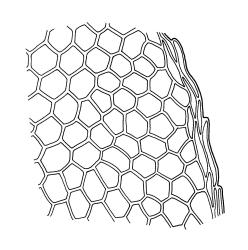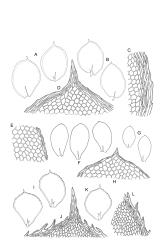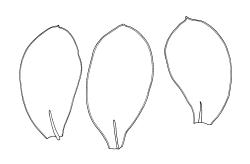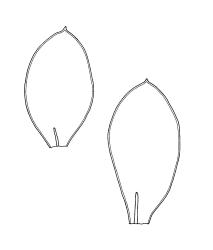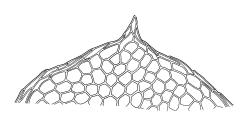- ≡ Eriopus brownii Dixon, Bull. New Zealand Inst. 3: 286 (1927)
Plants small, soft, usually dark green, moderately iridescent when dry, forming loose, often open turves. Stems sparsely branched, erect, red-brown below, 3–12(–25) mm long, in cross-section with a coloured, subcortical region of firm-walled cells, lacking a central strand, c. 200–225 µm diam., with scattered brown, smooth rhizoids below and a dense tuft at the stem base. Shoots complanate, c. 2.5–3.0 mm wide. Leaves delicate in texture, inserted in 6 ranks, becoming closer and larger acropetally, strongly asymmetric (especially in lateral ranks), not crisped when dry, obovate or broadly elliptic, tapered to broadly obtuse or broadly rounded and mucronate apices, plane at margins, weakly bordered throughout, entire, 1.3–2.1 × 0.7–1.0 mm (often smaller in ventral and dorsal ranks and on lower stem); upper laminal cells thin- or firm-walled, not or scarcely thickened in corners, 30–48 × 21–30 µm (l:w c. 1:5), gradually becoming larger basally; marginal cells linear, firm-walled and porose, forming a concolourous border 2–3 cells and 12–18 µm wide at mid leaf (rarely to 24 µm in patches and often fading to 1 cell wide near apex). Costa single and very short (< ⅙ the leaf) or absent, unbranched or rarely ± bifurcating.
Dioicous. Perichaetial leaves acuminate from a broadly obovate base, ecostate, not bordered, c. 1 mm. Perigonia ovoid, c. 1 mm, scattered on ♂ stems, with bracts shaped as perichaetial leaves, strongly concave, the inner yellow-brown, with 3–6 antheridia and lacking paraphyses. Setae 2–6 mm, straight or flexuose, stout (c. 180 µm diam.), with a few hyaline cells forming low mammillae (portions appearing undulate under microscope), pale brown, in cross-section with an ill-defined hyaloderm; capsules inclined, symmetric, ovoid, c. 1 mm, smooth when dry, pale yellow-green at maturity, turning red-brown with age. Operculum c. 0.5 mm long. Exostome teeth c. 300 µm long. Calyptra c. 1 mm, smooth above, strongly fimbriate at base. Spores 14–18 µm, green, smooth.
Sainsbury 1955, pl. 64, fig. 2 (as Eriopus); Streimann 2000, fig. 5.
Calyptrochaeta brownii is a well-characterised species and there is little difficulty in its recognition. In a N.Z. context the gametophytic features of entire, narrowly bordered vegetative leaves with rounded and mucronate apices serve to readily identify it. Stunted, epilithic material of Distichophyllum pulchellum could possibly be confused with this species, but the longer and clearly bifurcate costa of the Distichophyllum provides a means of ready distinction.
K (Ravine 8); NI: N Auckland, including offshore islands (HC, LB), S Auckland, Gisborne (Lottin Point Road near Potaka, Lake Waikaremoana), Hawke’s Bay, Wellington; SI: Nelson (D’Urville I.), Canterbury (Riccarton Bush, Banks Peninsula including Port Hills), Otago (near mouth of Taieri River).
Australasian. Tasmania*. Recorded from mainland Australia by Scott & Stone (1976) and by Streimann (2000).
On bark (Melicytus ramiflorus, Podocarpus laetus), tree fern caudices and bases, exposed roots, rotten wood, also on rocks or soil. Usually or always in deeply shaded, moist situations in mixed broadleaf or mixed broadleaf-podocarp forest and avoiding salt spray. This inconspicuous species can occasionally form rather "extensive turves", as on a sedimentary rock outcrop at the Taieri River mouth. Ranging from near sea level (Little Barrier I.) to 750 m (near Erua, Wellington L.D.) on the North I. and from near sea level (Taieri River mouth) to at least 580 m (Takamatua Valley, Banks Peninsula) on the South I.
Until Willis (1957) recorded it from Tasmania, C. brownii was considered a N.Z. endemic. Both Scott & Stone (1976) and Streimann (2000) have recorded this species from south-east mainland Australia. I have not examined mainland Australian material, but Streimann’s description and illustration permit no doubt as to its occurrence there.



